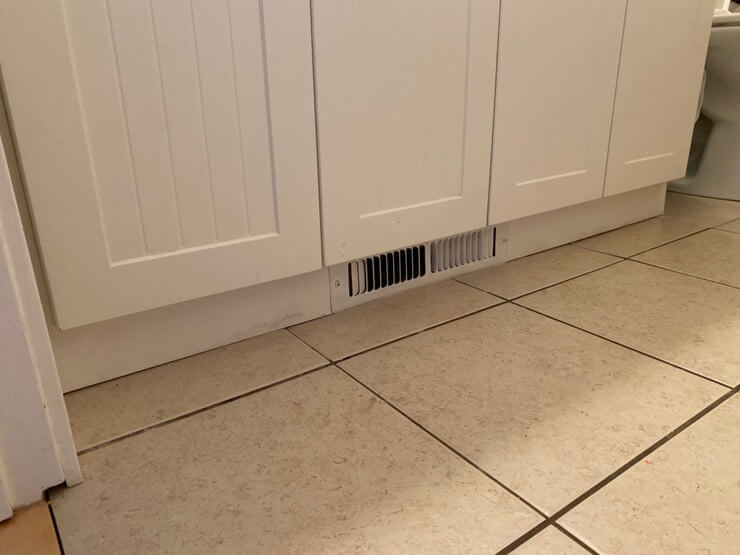Placing an HVAC vent under a bathroom vanity is a great option to keep your bathroom cool or warm. In addition, an HVAC vent under your vanity keeps the vent primarily out of sight, adding to the style of your bathroom.
There is debate amongst contractors and homeowners about whether venting under a bathroom vanity is a good idea and whether you should use a toe kick or ducting. In addition, many people wonder if placing an HVAC vent under a vanity complies with building code, or is an HVAC vent in a bathroom even required?
This article will help to answer your questions, put an end to debates, and alleviate your worries. We will discuss freestanding vanities over HVAC vents, fire hazards, ducting and alternative solutions.

Is It OK to Put a Freestanding Bathroom Vanity Over HVAC Vent?
Yes, in most cases, you should not have any problems placing a freestanding bathroom vanity over an HVAC vent.
Traditionally, HVAC vents are placed in walls in order to get the most airflow and the best heating or cooling possible. But freestanding vanities have empty space underneath them, allowing the air to flow into your bathroom. This creates sufficient ventilation and is why building codes do not have a problem with it.
You should not worry about building inspectors coming to fine you and redo your work by placing an HVAC vent underneath your vanity.
Another worry shared by many people is that the hot or cold air coming out of their vent could damage their bathroom vanity. I have had an HVAC vent under my vanity for over ten years, and the vanity shows no signs of damage.
Bathroom vanities are designed to have hot and cold water pipes running through them, so they are built to handle these temperature changes.
Does It Pose a Fire Hazard?
In most cases, putting an HVAC vent under your bathroom vanity does not pose a fire hazard.
There are some extreme cases in which dryer lint or other flammable materials got into an HVAC system and caused a fire. But the common cause of HVAC-related fires is bad electrical connections.
Placing an HVAC vent under a freestanding vanity will not be the cause of a fire in your system and can actually help to prevent flammable materials from falling into the HVAC system.
Also, an HVAC vent can give you early warning signs of a fire. As worn-out electrical connections cause most fires, you will get a burnt smell or even smoke coming out of your HVAC vent.
If this is the case, you should immediately call an HVAC technician and your local fire department immediately.
Duct or No Duct?
Some contractors swear by toe kicks, and others will tell you that using a duct or extending your duct is the only way to go.
Every vanity has a toe kick with space for your feet that allows you to stand directly in front of the vanity to use it for things like brushing your teeth and washing your hands.
Many contractors will utilize this toe kick area to place an HVAC vent. If you are not venting through your toe kick, then you are using a duct through your flooring or wall.
Toe kicks are an excellent option to vent your HVAC system. But in most cases, using a duct will be better.
If you choose to use a toe kick vent, in most cases, you will need a vent deflector to move the air properly. This deflector will cost you extra money if you buy one or extra time if you decide to make one.
Many toe kick vents have no ductwork leading from the HVAC register to the vent. This makes using ductwork a more efficient method to move air in and out of your bathroom.
Alternative Solutions
HVAC Wall Vent
One alternative to using a vent under your vanity is to use a wall vent instead. Wall vents have no obstructions, so the airflow you receive in your bathroom will be excellent.
Traditionally, HVAC units used wall vents, and this is an excellent alternative. The main downside of wall vents is that they affect the style of your bathroom by being visible and vents underneath vanities do their job while being unseen.
Stove or Furnace
If you have the vents for an HVAC system already in place, then a stove or furnace can be a great option.
If you have a supply of lumber on your land, this can be an inexpensive option as opposed to purchasing and installing an HVAC system.
One major issue with using a stove or furnace is it does not have all the capabilities of an HVAC system. A stove or furnace can only heat your home. It does not have the ability to cool or vent your home.
Conclusion
Many people worry about placing an HVAC vent underneath their bathroom vanity. However, it turns out that there is not much to worry about.
You should not have any problems with code compliance by venting your bathroom this way. Bathroom vents underneath a vanity are not fire hazards and can actually help you detect a fire before it spreads. Also, bathroom vents under your vanity will not cause damage to your vanity.
Placing a vent underneath your vanity is a popular choice that allows you all the benefits of HVAC, such as heating, cooling, and ventilation, without a visible vent within your bathroom.
Whether you choose a toe kick or a ductwork vent, you will have a great system that can take care of your bathroom’s temperature needs for years to come.

